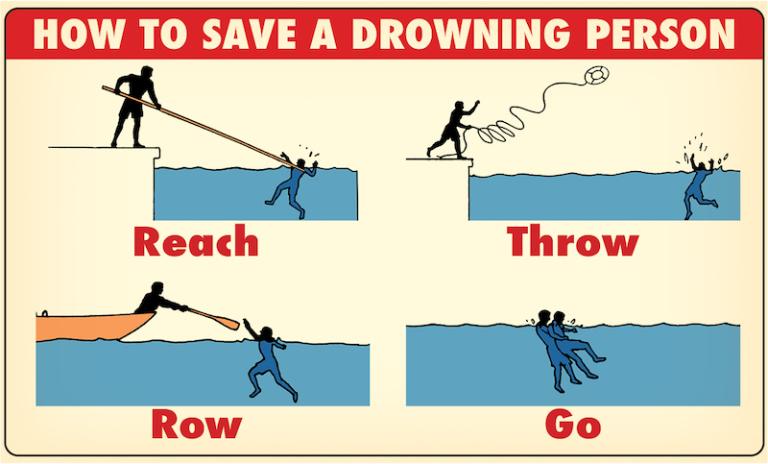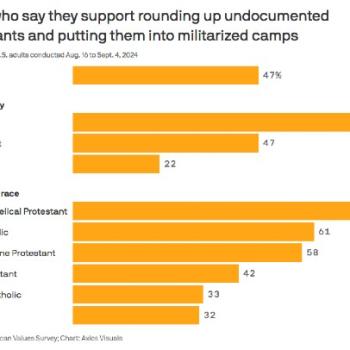You probably learned this as a kid at summer camp, or in school, or at the Y. It’s the basic safety mantra for assisting someone who is drowning or in distress in the water: Reach, throw, row, go.

The lesson here is the priority or hierarchy of measures to do what needs to be done to assist the person. Try the first one first. If that won’t work, try the second.
If you can’t REACH them with a pole or a tree branch or whatever else is handy then try method No. 2 and see if there’s anything you can THROW them that they can grab for help (something that floats, obviously). The life-preserver on a rope contraption kept on hand by lifeguards is ideal for this as a kind of throw-and-reach combined method. If neither of those methods is going to work, then the next best thing is to ROW — to get in a boat and head out to where they are. If that isn’t an option, then — and only then — should you GO, entering the water and swimming to the person in need of help.
“GO” is the last resort because it is the most dangerous for both of you. The same conditions of currents or waves that are threatening the distressed swimmer would also threaten you, and a distressed or drowning person can sometimes panic in a way that threatens the safety of anyone swimming out to assist them. There’s always a chance when you GO that instead of saving one person from death by drowning, you’ll wind up with two.
That concern is a big part of the reason that the “Reach, Throw, Row, Go” slogan has been so widely adopted all over the world. That’s why the last option — especially when teaching this to children — is sometimes changed to GO for help.

The idea here is that the one-drowning-turning-into-two scenario is far too likely for anyone who isn’t a trained lifeguard or first responder. And so this version of the slogan from the US Army Corps of Engineers explicitly warns “Don’t Go In, Get Help!” That warning, one assumes, doesn’t also apply to the help you’re instructed to go get. Presumably that “help” would come from a lifeguard or a firefighter or Katie Ledecky — someone capable of going in the water to assist the drowning person without putting their own life at risk.
Many versions of “Reach, Throw, Row, Go” combine both meanings of GO. That’s how it’s taught by NASBLA. the National Association of State Boating Law Administrators:
Go: Swimmers without lifesaving training should not swim to a victim. Instead, GO for help. If you must swim, take along anything that floats to keep between you and the victim.
Some variation of Reach, Throw, Row, Go is taught by just about every organization that involves people in, on, or around water. It’s taught in Girl Scouts, Boy Scouts, Awana, and Christian Service Brigade. It’s taught by the YMCA, by the FOP, by the USMC and by every other branch of the military.
But none of those lessons in “How to Save a Drowning Person” says anything about why you should save a drowning person.
Because they don’t have to. This is basic humanity. It’s Human Being 101. It’s a Voight-Kampff test for dummies.
Even when philosophers and ethics professors latch on to drowning-person scenarios to explore the nature of morality they assume this same baseline humanity as a starting point. Those professors will spin out a thousand drowning-person hypotheticals — usually involving multiple drowning people in a kind of aquatic trolly problem. Those vicious hypotheticals are cunningly designed to force you to choose to save one person or the other, because you can’t save them both. That painstaking construction is needed because the professor already knows that we — nearly all of us — urgently want to save them both.
A lesson in “How to Save a Drowning Person” that started with an argument for Why You Should Want To Do That would meet with a kind of puzzled anger. The suggestion that any of us would not automatically want to do that would at first be perceived as an accusation, and then as grounds for suspicion: What the heck is wrong with you that you’d think something like that would be wrong with us?
After all, this is why we humans needed to adopt something like Reach, Throw, Row, Go on such a widespread basis. Because too often the basic human response to another human in jeopardy is to recklessly endanger ourselves while trying to help. That’s just human beings being human.
Not all human beings, unfortunately. There are still sociopaths and psychopaths who couldn’t be bothered to reach, throw, row, or go to assist anyone, let alone a stranger.
And they seem convinced that the rest of us are somehow weaker or inferior because we want to “Save a Drowning Person.”
But remember that those anti-human people are only a fraction of humanity, even if sometimes one of them gets elected governor of Texas or wins the Iowa caucuses.













